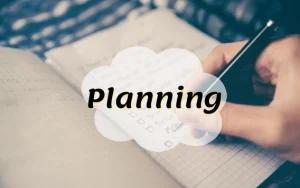Writing a good proposal is an essential skill required for almost all occupations. The goal of a proposal is to gain support for your plan by delivering business messages to the right audience. An effective proposal, with a clear, concise and engaging manner is crucial for success as it may help in getting your ideas approved.
編寫好的計劃書是幾乎所有職業都必需的基本技能。計劃書的目的是向適當的受眾傳遞業務消息並且希望能夠獲得他們對該計劃的支持。一個有效,清晰,簡潔和引人入勝的計劃書對於成功至關重要,因為它極可能讓你的計劃得到批准。
Don’t rush the proposal! Before you go in-depth, sit down and plan the outline!
不要著急和盲目的寫!在深入之前,請坐下來並規劃你要傳遞的重點!

???????? PLANNING 規劃
1. Identify your audience 確定您的受眾群體
You need to think about your audience and consider what they might already know or not know about your topic before you begin writing. This will help you focus on your ideas and present them in the most effective way. Make sure key messages reach to your audience via a right channel.
It’s good to always assume that your readers are busy and they do not have time to read or skim through the ideas in a rush. So, keep things short and clear!
在開始寫計劃書之前,您需要考慮你的聽眾,並考慮他們對你接下來的話題的了解度。這將幫助您專注於你要傳遞的信息,並以最有效的方式展示它們。確保關鍵消息通過正確的渠道傳達給您的聽眾。
你應該假設您的聽眾很忙,而他們也沒有時間閱讀你的所有內容。因此,請保持簡短明確!
2. State the problem 陳述問題
It is clear to you what the issue is, doesn’t mean it’s clear to your audience.
Also, audience may be skeptical of what you’re telling. You can support your points by using evidence and explanations throughout the proposal to back up your assertions. By pointing out your issue properly, it is much more convincing that you are the right person to take care of it.
您很清楚問題出在哪裡,並不意味著您的聽眾也一樣明白。
此外,聽眾可能會對您講的內容有所懷疑。您可以在計劃案中使用證據和實例探究來支持您的觀點,以支持您的主張。通過正確指出您的問題,可以說服您是解決問題的合適人選。
3. Define your solution 尋找解決方案
After stating the problem, you need to offer solutions that will convince skeptical readers to support it. You may support your solution with some case studies to show audience why it works.
If the examples you use are case studies that shows successful implementation of solution, tell the audience why it worked. And if it’s unsuccessful, tell the audience why it failed and how are you going to improvise and make it a success.
在陳述問題之後,您需要提供解決方案來說服讀者以及得到他們的支持。您也可以使用一些案例研究來支持您所提出的解決方案,以向受眾解釋為什麼你選擇這個解決方案以及展示為什麼這個方案能夠起作用。
如果您使用的示例是成功的案例研究,請告訴聽眾為什麼可行。如果未成功,請告訴觀眾失敗的原因,以及如改善與加強並取得成功。
Once you’ve gathered all the important points, you may continue by outlining your ideas and plan on how you would like your messages to be presented.
收集了所有要點後,您可以繼續概述您的想法,併計劃如何表達您的信息。

???????? WRITING 寫作
1. Introduce yourself and your company 自我介紹
You need to catch your audience’s attention, establish credibility, divert them to your topic, and motivate them to continue reading. Give a brief introduction about yourself and your company, state the purpose of your proposal. Highlight the issue and why it must be addressed immediately. Conduct comprehensive research, give them facts instead of personal opinions. Make your whole proposal as purposeful and informative as possible.
您需要引起觀眾的注意,建立信譽,將他們轉移到您的主題上,並引領他們繼續閱讀。簡單介紹一下您自己和您的公司,並說明這個計劃書的目的。強調該問題以及為什麼必須立即解決。進行全面研究,給他們事實而不是個人意見。你必須讓整個計劃書有著充分的信息量。
2. State the problem 陳述問題
After the “hook”, you’ll get into the body of your proposal. Here’s where you should state everything about your problem. You need to tell them the cause of the problem, emphasize why it needs to be solved now. Give your audience a clearer picture of how it will affect them if the problem is left unsolved.
Make sure to answer all questions with research and facts to enhance credibility.
當觀眾都被您吸引之後,你將開始進入計劃書的正文。在這裡您應該陳述有關問題的所有信息。您需要告訴他們問題的來源,強調為什麼需要立刻解決。讓您的聽眾更清晰地了解如果問題仍未解決,它將如何影響他們。
確保用研究成果以及一些數據來回答所有問題,以提高可信度。
3. Propose solutions 建議解決方案
This is the most important part of your proposal. Your audience has been listening to you from the beginning just to wait for this moment. The solutions section is where you get into how you will address the problem, why you’ll do it in this way, and what will the outcomes be.
In general, writing a proposal is mainly about addressing the problem and how to solve it. Research your proposal extensively. The more examples and facts you can give your audience, the better as it’ll be much more convincing. Avoid personal opinions and rely on the research done by other researchers.
Do not give solution that is not feasible. Prove how your solutions work.
這是您計劃書中最重要的部分。觀眾從一開始就一直在專心的聽你說,為的就是這一刻。在解決方案部分中,您將了解如何解決問題,為何以這種方式解決問題以及取得的結果。
通常,編寫計劃書主要是關於解決問題以及如何解決它。廣泛研究您的計劃書內容。提供的示例和數據越多,越有說服力。避免發表個人意見,並依賴其他研究人員所做的研究。
不要給出不可行的解決方案。你要證明如何去實行你所提出的解決方案。
4. Timeline and budget 時間表和預算
In order to convince your readers that your proposal is a sensible investment, and you want them to think that you’re someone who is very detailed and they can count on you to handle their problem, you need to provide detailed and concrete information about your timeline and budget.
Provide stage by stage timeline is important. Being as meticulous as possible will give your readers confidence that you’ve done your homework and won’t waste their money.
Most importantly, make sure your proposal makes sense financially. Take into consideration of your audience’s budget. If they can’t afford your proposal, it’s pointless. You need to think of an alternative way to create a proposal that suits their budget and at the same time maximizing the result.
為了讓您的聽眾相信您的計劃案是明智的投資,並且希望他們認為您是一個非常詳細的人,他們可以依靠您來解決他們的問題,您需要提供的不只是詳細和具體的信息。你還需要加上時間軸和整個計劃的預算。
逐步提供時間表很重要。盡可能的細緻會讓您的聽眾相信您已經做好充分的準備,不會浪費他們的錢。
最重要的是,請考慮您的受眾群體的預算。如果他們負擔不起您的建議,那是沒有意義的。您需要考慮一種替代方法來創建適合其預算的提案,同時使結果最大化。
5. Wrap up with a conclusion 總結
The conclusion of your proposal should correspond with your introduction, briefly wrapping up the messages you want to deliver to your audience once again. And, as always, thank them for their consideration and time.
計劃書的結論應與您一開始的介紹相符,簡要地總結您要傳達給受眾的信息。更別忘了,一如既往,感謝他們的考慮和時間。

